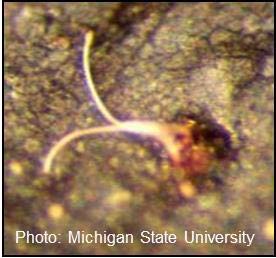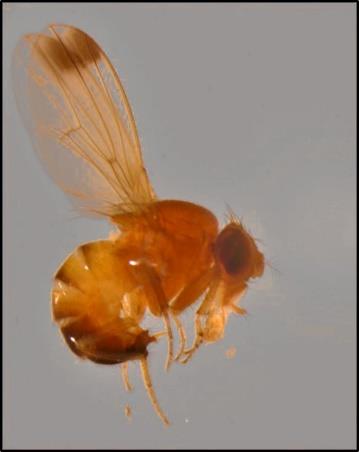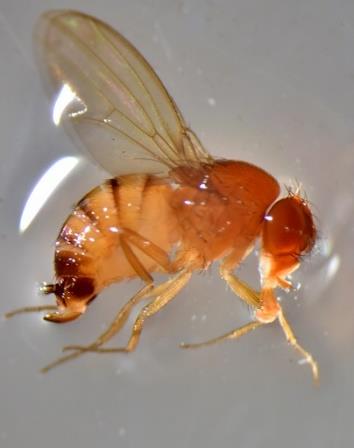Update – Spotted Wing Drosophila in Wisconsin Cherries
The now infamous invasive pest, spotted wing drosophila (SWD), has devastated yield and marketability of raspberry crops across Wisconsin, and also has the potential to damage other Wisconsin crops, including cherries. This has been seen in Oregon, Washington and California’s sweet cherry producing regions, starting in the summer of 2009 immediately following its introduction. More recently, and hitting closer to home, significant losses have been reported in Michigan and Wisconsin tart cherry production. In 2015, SWD caused an estimated 10-15% crop loss in tart cherry production in Door County, with some growers suffering complete crop loss. So, what is the likelihood that SWD will cause damage in Door County cherries this year, and what can be done to protect our crops?
In the Guédot Lab, when we began tracking SWD populations in 2013, we hoped that early ripening fruit such as strawberries and tart cherries would be harvested before SWD populations start to build up to levels that could cause significant damage. However, according to Matt Stasiak, Peninsular Ag Research Station Superintendent, the arrival time of SWD in cherry orchards has been earlier each year (July 21 in 2013; July 11 in 2014; and July 3 in 2015).
This year we have already seen the first SWD in Door County – a female was trapped in early June in Door County and another female has recently been trapped in Michigan. This earlier arrival of SWD means that infestations are likely to coincide with cherry ripening and harvest this year and in the future. For this reason, we would advise you to monitor for the arrival of SWD in Door County cherry orchards, and to be prepared to take appropriate control measures when necessary.
Monitoring for larval SWD
Monitoring is a crucial element of Integrated Pest Management for SWD in cherry, especially since SWD is not yet an established pest of cherries in Wisconsin, and some orchards will experience little or no damage while others may experience significant damage. The easiest way to monitor for SWD is to trap the adults; however, this can be misleading since adult presence does not necessarily indicate that the larvae are feeding on or damaging cherries. To be sure whether SWD is in fact in your fruit, it is best to monitor for SWD eggs and larvae in the cherries themselves, as well as monitoring for adults in the area.

To see the presence of eggs on the fruit surface, look for breathing tubes (image at right) and pits on the outside of the fruit. For larval detection, place suspected fruit in a Ziploc-type bag, slightly crush the fruit and add a salt water solution (1/4 cup salt and 4 cups water). Leave the fruit in the mixture for one hour. Dislodged larvae will float. Backlighting the bag should facilitate detection. Another method is to boil suspected cherries in 150 milliliters (approx. 5‐6 ounces) of water for one minute, then gently crushing the cherries over a 4 mesh screen with a spoon, and finally rinsing the fruit under cold water with a dark tray underneath to collect the juice and larvae. The dark tray should facilitate detection of larvae.
Larvae from a number of species of fly could be present in already damaged or diseased cherry fruit. To confirm that the larvae you find in the fruit are SWD, first collect coloring damaged fruit and place them in a Ziploc bag to let the adults emerge (less than 10 days, depending on the size of the larvae). When the adults emerge, place the bag in the freezer to stun the flies. The flies can then be identified (see SWD adult identification guide below).
Monitoring for adult SWD
Along with larval monitoring, it is recommended to also monitor for SWD adults during the growing season, to be able to detect presence of SWD as quickly as possible. Adult SWD traps are available commercially, but are also simple and inexpensive to make: simply use a 32 oz. clear plastic deli cup with a lid, and drill or melt ten 3/16″ inch holes around the top of the cup to allow adults to enter. Larger holes will allow larger insects to enter and will make counting SWD more difficult. Leave ~3-4 inches without holes to allow easy pouring of the liquid bait. Traps can be baited with ~1 inch of a yeast-sugar mix (1 Tbsp. active dry yeast: 4 Tbsp. sugar: 12 oz. water: a couple drops of unscented soap). The soap will break the surface tension of the liquid bait and allow the flies to drown. If you would prefer to buy commercially-prepared traps and lures, they are available from Great Lakes IPM, Scentry and Trece.
Whether you use commercially bought or home-made traps, they should be hung in the shaded plant canopy where fruit are present. Place about one trap per acre. Check traps weekly. Lures are generally replaced every 3-4 weeks, although you should check with the product information for exact directions. If using a home-made liquid bait, replace it weekly. Do not pour yeast-bait out at the base of the trap as it will confuse the adults and reduce the effectiveness of the trap. You can dispose of the bait either in a bucket or on the ground away from the monitored crop. A hand‐lens (at least 30x magnification) or a microscope will be useful for identifying male SWD and required for identifying female SWD.
SWD adults have certain characteristic features that help with identification. Males generally have a single dark colored spot at the tip of each wing, and always have two dark colored bands on each foreleg (only visible with magnification). Females lack the wing spots, but possess a unique, serrated ovipositor (egg laying device), which distinguishes them from other vinegar flies. The serrated ovipositor is also only visible with magnification.
Cultural controls for SWD in cherry
Minimize the buildup of SWD: Minimize the buildup of SWD by removing native wild hosts such as blackberries, plums, dogwoods, and honeysuckle. Schedule timely harvests and remove over-ripe or infested fruit from the orchard as soon as possible to prevent the development of eggs and larvae.
Dispose of infested fruit: You can place infested fruit inside a plastic bag, seal the bag, and solarize the bag. If you have a lot of infested fruit, you can lay them on the ground in a sunny area, cover all the fruit with a piece of clear plastic, and seal the plastic with soil around the edges. You can also bury the fruit, at least 2 feet deep. Important note: DO NOT compost fruit, it might actually speed up SWD development in warm areas of the compost piles! Freezing cherries will kill SWD and refrigerating cherries (<40F) will stop further development of eggs and larvae inside the fruit and may kill eggs and larvae after longer refrigeration periods. It is thus recommended to keep cherries cool as much as possible, from processor to market to consumer, as it will minimize the chance that larvae will continue developing in fruit.
Biological controls for SWD in cherry
To date there has not been a lot of research into the potential for biological control as a viable method of control for SWD in Wisconsin. However, biocontrol could be a particularly suitable control tactic since, unlike chemical controls, high numbers of biocontrol agents could control SWD on non-crop hosts in the surrounding landscape, as well as in the cherry crop. Data from other states and from Europe has shown that pupal parasitoid wasps are able to reduce SWD numbers (Wang et al. 2016, Rossi Stacconi et al. 2013). Larval parasitoids show less promise, since SWD larvae have a highly effective immune response against parasitoids (Chabert et al. 2012). However, no research has yet taken place to determine whether these parasitoid wasps are present in the upper Midwest, or what level of parasitism of SWD is naturally occurring now that this pest has been established here for over four years.
Hopefully future work will elucidate if there are naturally occurring biocontrol agents we can encourage in Wisconsin, and will provide us with commercially available biocontrol agents of SWD. For now, some general techniques to sustain your naturally occurring biocontrol agents include planting continually-blooming wildflower areas to provide nectar, pollen and shelter resources for adult predators and parasitoids (and pollinators!), and avoiding broad-spectrum insecticide applications whenever possible.
Chemical controls for SWD in cherry
A list of insecticides that have been shown to be effective against SWD in cherry is provided below. Spray in short intervals (7-10 days depending on product used) to prevent crop infestation from when the fruit is beginning to ripen until harvest is completed (taking pre-harvest intervals into account). Make sure to calibrate your sprayers to provide thorough coverage, especially in the center of the canopy where flies like to hide in the shade.
| Class (IRAC) | Trade name | Active ingredient | REI | PHI (days) | Rate (per acre) | Comments |
| Organophosphates (1B) | Diazinon | Diazinon | 4 days | 21 | ½ – 1 lb/100 gals water | Max of 4 lbs./acre/application. Max of 2 applications/year. (max of 1 as dormant application and max of 1 as in-season foliar application). Caution: Closed cab required. |
| Imidan 70W highly effective | Phosmet | 3 days* | 7 | 2 ⅛ lbs | TART CHERRIES ONLY! Max of 7 ½ lb/acre/year * “Pick your own” REI = 14 days | |
| Pyrethroids / Pyrethrins (3A) | Asana XL | Esfenvalerate | 12hrs | 14 | 4.8 – 14.5 fl. oz. | Max of 72 fl. oz./acre/year, with no more than 57.6 fl. oz./acre between bloom and harvest. |
| Baythroid XL | Beta-cyfluthrin | 12 hrs | 7 | 2.4 – 2.8 fl. oz. | Max 5.6 fl. oz./acre/year. Max 2 applications/season. | |
| Danitol 2.4EC highly effective | Fenpropathrin | 24hrs | 3 | 10⅔ – 21⅓ fl. oz. | Max of 42⅔ fl. oz/acre/year. Max 2 applications/season. Caution: Do not apply as ULV spray. Do not allow livestock to graze on cover crops from treated orchards. | |
| Mustang Max 0.8EC highly effective | zeta- Cypermethrin | 12hrs | 14 | 4 oz. | Max of 24 oz./acre/year. 7-day interval between applications. Caution: Do not apply as ULV spray. Do not allow livestock to graze on cover crops from treated orchards. | |
| Warrior II highly effective | Lamda- cyhalothrin | 24hrs | 14 | 2.56 fl. oz. | Max of 12.8 fl. oz/acre/year. Max 10.24 fl. oz./acre/year post-bloom. 5-day interval between applications. | |
| Pyganic OMRI | Pyrethrum | 12hrs | 0 | 16 – 64 oz. | Recommended that final spray mix be buffered to pH of 5.5 – 7.0. 0 day interval between applications. | |
| Spinosyns (5) | Delegate WG highly effective | Spinetoram | 4hrs | 7 | 4.5 – 7 oz. | Max 28 oz./acre/season. Max 4 applications/year. 7-day interval between applications. |
| Entrust OMRI highly effective | Spinosad | 4hrs | 7 | 1.25 – 2.5 oz. | Max of 9 oz./acre/season. No more than 2-3 consecutive applications of group 5 insecticides/season. Rotate with Pyganic for resistance management in organic production. 7-day interval between applications. | |
| METI-acaricides and insecticides (21A) | Apta highly effective | Tolfenpyrad | 12hrs | 14 | 21 – 27 oz. | Max 54 oz./acre/season Max 2 applications/season |
| Diamides (28) | Exirel highly effective | Cyantraniliprole | 12hrs | 3 | 13.5 – 20.5 oz. | Max 3 applications/season. |
This is not a comprehensive list. Research is ongoing and recommendations for SWD are constantly changing as research results become available. Please, make sure to always read and follow label instructions carefully. Human error happens, so please double check rates and other information on the label! Experience from other states suggests using the full label rate for each product against SWD, until we have more information on pesticide efficacy.
Cherries for export have to follow the MRLs guidelines on pesticide residues set by the country of destination. Check with your packinghouse when choosing your SWD spray program to comply with the MRL requirements of the country of destination. Additionally, this MRL Chart for Tart Cherry created at Michigan state University provides a handy guideline for export residue limits, but you should always double check with your packinghouse for the most up-to-date information.
Organic Production
Two insecticides, Entrust and Pyganic, are OMRI approved. Rotate Entrust (5- to 7-day residual) with Pyganic (2- to 3-day residual) to achieve some resistance management. Organic insecticides are less effective than conventional insecticides, and so requires more intensive monitoring, more timely application, and shorter intervals between sprays. Cultural controls are even more important to help reduce overall SWD population levels. Using these recommendations, experience from some West Coast states suggests that SWD populations can be successfully managed in organic production.
References Cited:
Chabert, S., R. Allemand, M. Poyet, P. Eslin, and P. Gibert. 2012. Ability of European parasitoids (Hymenoptera) to control a new invasive Asiatic pest, Drosophila suzukii. Biological Control 63:40–47.
Rossi Stacconi, M. V., A. Grassi, D. T. Dalton, B. Miller, M. Ouantar, A. Loni, C. Ioriatti, V. M. Walton, and G. Anfora. 2013. First field records of Pachycrepoideus vindemiae as a parasitoid of Drosophila suzukii in European and Oregon small fruit production areas. Entomologia 1:3.
Wang, X.-G., G. Kaçar, A. Biondi, and K. M. Daane. 2016. Foraging efficiency and outcomes of interactions of two pupal parasitoids attacking the invasive spotted wing drosophila. Biological Control 96:64–71.
This article was posted in Insects and tagged Cherry, Christelle Guédot, insects, Janet van Zoeren, Spotted Wing Drosophila, SWD.


